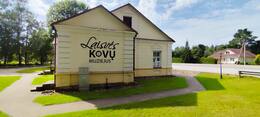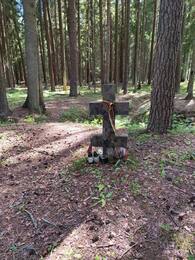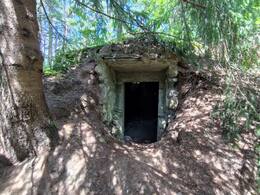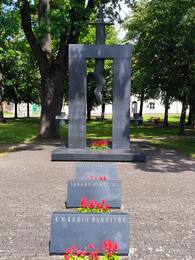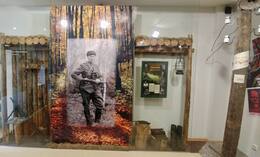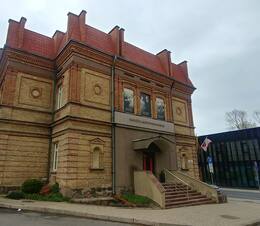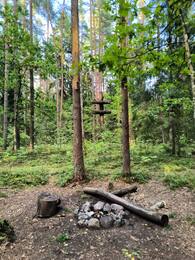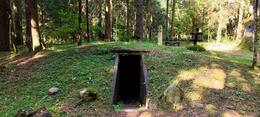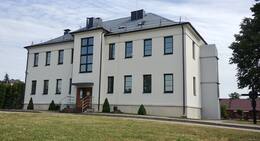Partisan Roads and Trails in Aukštaitija
Museum of the Battles for Freedom in Utena
The museum is located in Utena, near the junction of the Kaunas-Daugpilis (A6) and Vilnius-Utena (A14) trunk roads. The museum was established in 2015 at the former narrow gauge railway station building of Utena. The museum claims to be a form of poetry that tacitly exposes the post-war truth. The exhibition “A Common European Identity in the Context of Totalitarian Regimes” offers to explore the past of Lithuania and Europe through the history of one Lithuanian region. It tells the story of secret documents and the division of Europe in 1939, the Soviet occupation of Lithuania, the forced participation of Lithuanians in World War II, exile, post-war resistance and the organisation of collective farms in the Utena region. The painful events of 1940–1965 in the Utena region and the events in Lithuania are contrasted with life behind the Iron Curtain. The history of the narrow-gauge railway station also has tragic pages. From here, in 1941 and from 1945–1953, train cars with deportees were sent to Siberia.
Along the Trails of the Partisan Battles of the Algimantas Military District
Located in Šimonys Forest, along road No. 1216 (a sign and a stand have been installed). Šimonys Forest was known in the post-war Lithuanian partisan struggle as the centre of activity of the largest partisan unit in Aukštaitija, the Algimantas military district. Approximately 200 partisans were operating in the area in 1945, while by 1952, there were only 20–30. From 1947 to 1949, the Šimonys Forest was used by the commander of the East Lithuania (King Mindaugas) partisan territory, Captain Jonas Kimštas-Žalgiris, and in 1949, by the commander who took over from him, Antanas Starkus–Montė, as hiding places – command posts from which the partisan movement in Aukštaitija was coordinated. The route of the partisan battles of the Algimantas military district invites you to get acquainted with six partisan hideouts of the Algimantas military district, created by the partisans of the Žalioji, Šarūnas and Kunigaikštis Márgiris (King Márgiris) units, who hid and fought here. There are two walking routes of different lengths (5 and 10 km) in Šimonys Forest, which invite you to follow the paths of the partisans.
Eastern Lithuania (King Mindaugas) region Lithuanian partisan command post
After driving past Andrioniškis Cemetery (there is a signpost), there is a preserved hideout – a command post. From 1944– 1949, a command post of the Lithuanian partisans of the Eastern Lithuania (King Mindaugas) region operated in this hiding place. In the summer of 1944, Balys Žukauskas, with brothers Petras and Juozas Jovaišos, established the hiding place to evade the mobilisation announced by the Red Army in 1944. At the end of 1945, Antanas Slučka-Šarūnas started to use the hiding place. He was the first one to form a partisan unit in the Troškūnai area and later united the partisans of Rokiškis, Anykščiai, Kavarskas, Troškūnai, and Andrioniškis to form the Šarūnas Unit. In 1947, A. SlučkaŠarūnas became the commander of the Algimantas district, and in 1949 – the commander of the Eastern Lithuania partisan region. This means that from 1949, the hiding place became the command post of the Lithuanian partisans in the Eastern Lithuania region. The hiding place, which had successfully sheltered partisans for five years, was betrayed on 28 October 1949. The farm where the partisans were hiding was besieged by KGB troops; the partisans refused to surrender and blew themselves up.
The bunker has been preserved, and a cross and a monument to the fallen have been installed.
Monument dedicated to Algimantas Military District partisans
The monument is located in the centre of Troškūnai, Anykščiai district, near the Church of Holy Trinity. During the partisan war of 1944–1953, the territory of Lithuania was divided into nine partisan military regions. From 1947–1950, partisan units of the Algimantas region of Lithuania, the establishment of which is closely related to Troškūnai, were active in the Panevėžys and Anykščiai area. The inhabitants of this town organised partisan units in Aukštaitija. The first partisan commander of the Algimantas region, Antanas Slučka-Šarūnas, was born and lived in Troškūnai.
In 1996, pursuant to the initiative of the Genocide and Resistance Research Centre of Lithuania, a monument dedicated to the partisans of the Algimantas Military District was erected in Troškūnai. The monument was created by sculptor Jonas Jagėla and architect Audronė Kiaušinienė. The main part of the monument is a black stone gate that symbolises the fallen defenders of the homeland. The bronze crosses on the sides of the gate symbolise the Christian faith, while the bronze sword, like the sword of St Michael the Archangel, symbolises the light of faith and hope. In the square in front of the monument, a black stone plaque commemorates the three units of the Algimantas region: Šarūnas, Žalioji and Kunigaikštis Márgiris.
Exposition on the Resistance to Soviet Occupation and Sąjūdis at the Panevėžys Local Lore Museum
The exposition is located in an authentic place – the premises of the Panevėžys group of the Lithuanian reform movement “Sąjūdis”. The Sąjūdis of Panevėžys has been operating here since October 1988.
In 2004, an exposition on the resistance to the Soviet occupation and an exhibition dedicated to the “Sąjūdis” were opened in the building. The exposition reveals the extent and forms of popular resistance starting from 15 June 1940 to 11 March 1990, and introduces the most importantstages and events of the anti-Soviet movement, as well as Soviet repressions.
Expositions “Okupacijų gniaužtuose” (“In Squeeze of Occupations”) and “Raudonasis teroras” (“Red Terror”) at the Panevėžys Local Lore Museum
The expositions are located in downtown Panevėžys. The Soviets confiscated the house, built at the end of the 19th century for the rominent Moigiai family of Panevėžys. From 1940–1941 it housed the headquarters of the Soviet military unit, the interrogation department of the NKGB (People’s Commissariat for State Security) of Panevėžys District and the militia. From 1944 to 1953 it was the headquarters of the Panevėžys County NKGB-MOI-KGB. It is now the premises of the Panevėžys Local Lore Museum.
The Exposition “Okupacijų gniaužtuose” (“In the Squeeze of Occupations”) presents the Nazi and Soviet occupations. It introduces the themes of the Jewish and Roma genocide, deportations and the themes of partisan war. The part of the exhibition devoted to the years 1953–1990 tells the story of everyday life in Khrushchevka, the efforts of the Soviet government to create a Soviet society, the resistance of people to this violence, and the activities of the underground. You can hear recordings of radio broadcasts from abroad, secretly listened to by the people of the time, with radio interference caused by the Soviet authorities.
The exhibition “Raudonasis teroras” (“Red Terror”) is dedicated to the memory of the victims who were killed in the basement of this house, shot at the Panevėžys sugar factory, as well as the history of the crimes committed by the Soviet occupation regime. The hopes of free people and the destruction thereof under Soviet rule are allegorically depicted in time and space – the interior of the apartment of the merciful Sister Zinaida Kanis-Kanevičienė at the time of the independent Lithuania, who was tortured to death, and a replica of the interrogation room of the NKGB.
Partisan Bunker in Žadeikiai Forest
The area is accessible via a forest road, which is located by taking road No. 3111 past Rinkūnai and crossing the River Pyvesa.
After the War of Independence (1918–1940), northern Lithuania, especially Pasvalys and Joniškis districts, had a strong tradition of partisan fighting. The first partisan units were organised here. This tradition, although not very pronounced, continued after the Second World War, and, in 1944, separate partisan units began to form in the region.
From 1944–1946, Jonas Alenčikas-Dragūnas was the commander of the partisan unit operating in Žadeikiai Forest. In 1945, the partisans led by him set up a rather large bunker in Žadeikiai Forest – it was 30 metres long and 6 metres wide. Such type of bunker perfectly reflects the first phase of the Lithuanian partisan struggle, when the partisans operated in large units and lived in large bunkers or forest camps. The bunker was destroyed during a battle, but when Lithuania regained its independence, it was rebuilt by the Pasvalys Infantry Company. The bunker is currently maintained by the Pasvalys Museum of Local History. A partisan settlement has been restored next to the bunker, and a new memorial cross and information stand have been installed.
Partisan bunker and memorial cross in Plunksnotiai forest
Partisan Bunker and Memorial Cross can be found by turning off the regional road 3604 (Rokiškis-Maineivos- Naujasodė) between Juodupė and Žiobiškis in the direction of Plunksnočiai Forest.
In 1947, the partisans of the Gediminas Company of the Kunigaikštis Márgiris (King Márgiris) Unit, led by Juozas Bulavas- Iksas, were located in the Plunksnočiai forest stand. Until 1948, they did not have a permanent wintering place, so they took refuge with people who supported them. After World War II, Plunksnočiai Forest was a swampy area with a small mound in the middle of the swamp. In 1949, the partisans set up a hiding place there. However, they were betrayed by an infiltrated Russian security agent, who knew the location of the bunker. On 14 November 1949, after the partisans had fallen asleep, he threw antitank grenades into the bunker. Seven partisans died.
The partisan bunker has been restored and a memorial cross with the names of those who died there has been erected. Today, the surrounding forest is green and walkable. A monument and information signs have been erected in a small square a few dozen metres from the bunker, pursuant to the initiative of the Young Riflemen of Rokiškis.
Museum of the History of Freedom Struggles in Obeliai
The Museum of the History of Freedom Fights is located on Vytauto Street, Obeliai (Obeliai-Zarasai road KK117) on the left side (a road sign is installed on the road).
Founded in 1998, the museum introduces the development of the Lithuanian state, the history of the Obeliai region and Lithuanian folk art. A large part of the exhibition is devoted to the theme of freedom fights.
The evidence of the freedom fights was collected and donated to the museum by a teacher and former partisan, Andriejus Dručkus (1928–2018).
In addition to the themes of Soviet repressions, deportations, the partisan war, the anti-Soviet resistance movement, and the rebirth of independence, which reflect the experiences of the Obeliai region, the museum also stands out due to its peculiar accents. The museum presents the history of the erection, destruction and restoration of the unique monument dedicated to the participants of the June 1941 uprising and the victims of Soviet terror. An overview of the Lithuanian defence system after 1990 is also provided, as well as uniforms of the Lithuanian Armed Forces and other services. The open-air exhibition of the museum has replicas of a Lithuanian partisan bunker and a Siberian barracks for deportees on display. The sites can be visited individually, and special educational programmes are also offered, which enable visitors to experience the everyday life of partisans and deportees to understand what it was like to live in a bunker or barracks.
Antazavė Battle Site and Partisan Dugout Shelter at Lake Vincežeris
The site can be accessed from the town of Antazavė by forest roads.
At the end of 1944, the Lokio Unit of Lithuanian partisans was formed in the area of Antazavė in north-eastern Lithuania. It was led by a former Lithuanian Army officer, Captain Mykolas Kazanas. The unit established five dugout shelters at Lake Vinčežeris, in the uplands of the dense spruce and pine forests of Antazavė.
On 26 December 1944 (27 December according to other sources), the Battle of Antazavė Forest took place here. It was one of the largest partisan battles in eastern Lithuania. The partisan camp was surrounded by Soviet Army units from Utena and Zarasai, as well as soldiers stationed in Antazavė Parish. After a day-long struggle, 85 partisans managed to break the siege and successfully retreated. One partisan died during the retreat.
Currently, two partisan dugouts have been built on the site of the partisan camp, and battle positions, a cross, a memorial plaque, and benches for visitors to the camp have been installed at the site. The partisans’ dugouts are outstanding in terms of their size – they are relatively large and massive underground structures and differed significantly from partisan bunkers that were later built in the forests of Lithuania.




